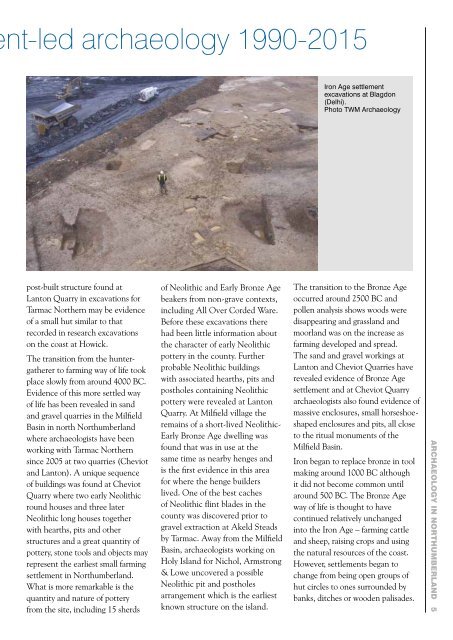Archaeology in Northumberland
Celebrating 25 years of Archaeology in Northumberland
Celebrating 25 years of Archaeology in Northumberland
Create successful ePaper yourself
Turn your PDF publications into a flip-book with our unique Google optimized e-Paper software.
nt-led archaeology 1990-2015<br />
Iron Age settlement<br />
excavations at Blagdon<br />
(Delhi).<br />
Photo TWM <strong>Archaeology</strong><br />
post-built structure found at<br />
Lanton Quarry <strong>in</strong> excavations for<br />
Tarmac Northern may be evidence<br />
of a small hut similar to that<br />
recorded <strong>in</strong> research excavations<br />
on the coast at Howick.<br />
The transition from the huntergatherer<br />
to farm<strong>in</strong>g way of life took<br />
place slowly from around 4000 BC.<br />
Evidence of this more settled way<br />
of life has been revealed <strong>in</strong> sand<br />
and gravel quarries <strong>in</strong> the Milfield<br />
Bas<strong>in</strong> <strong>in</strong> north <strong>Northumberland</strong><br />
where archaeologists have been<br />
work<strong>in</strong>g with Tarmac Northern<br />
s<strong>in</strong>ce 2005 at two quarries (Cheviot<br />
and Lanton). A unique sequence<br />
of build<strong>in</strong>gs was found at Cheviot<br />
Quarry where two early Neolithic<br />
round houses and three later<br />
Neolithic long houses together<br />
with hearths, pits and other<br />
structures and a great quantity of<br />
pottery, stone tools and objects may<br />
represent the earliest small farm<strong>in</strong>g<br />
settlement <strong>in</strong> <strong>Northumberland</strong>.<br />
What is more remarkable is the<br />
quantity and nature of pottery<br />
from the site, <strong>in</strong>clud<strong>in</strong>g 15 sherds<br />
of Neolithic and Early Bronze Age<br />
beakers from non-grave contexts,<br />
<strong>in</strong>clud<strong>in</strong>g All Over Corded Ware.<br />
Before these excavations there<br />
had been little <strong>in</strong>formation about<br />
the character of early Neolithic<br />
pottery <strong>in</strong> the county. Further<br />
probable Neolithic build<strong>in</strong>gs<br />
with associated hearths, pits and<br />
postholes conta<strong>in</strong><strong>in</strong>g Neolithic<br />
pottery were revealed at Lanton<br />
Quarry. At Milfield village the<br />
rema<strong>in</strong>s of a short-lived Neolithic-<br />
Early Bronze Age dwell<strong>in</strong>g was<br />
found that was <strong>in</strong> use at the<br />
same time as nearby henges and<br />
is the first evidence <strong>in</strong> this area<br />
for where the henge builders<br />
lived. One of the best caches<br />
of Neolithic fl<strong>in</strong>t blades <strong>in</strong> the<br />
county was discovered prior to<br />
gravel extraction at Akeld Steads<br />
by Tarmac. Away from the Milfield<br />
Bas<strong>in</strong>, archaeologists work<strong>in</strong>g on<br />
Holy Island for Nichol, Armstrong<br />
& Lowe uncovered a possible<br />
Neolithic pit and postholes<br />
arrangement which is the earliest<br />
known structure on the island.<br />
The transition to the Bronze Age<br />
occurred around 2500 BC and<br />
pollen analysis shows woods were<br />
disappear<strong>in</strong>g and grassland and<br />
moorland was on the <strong>in</strong>crease as<br />
farm<strong>in</strong>g developed and spread.<br />
The sand and gravel work<strong>in</strong>gs at<br />
Lanton and Cheviot Quarries have<br />
revealed evidence of Bronze Age<br />
settlement and at Cheviot Quarry<br />
archaeologists also found evidence of<br />
massive enclosures, small horseshoeshaped<br />
enclosures and pits, all close<br />
to the ritual monuments of the<br />
Milfield Bas<strong>in</strong>.<br />
Iron began to replace bronze <strong>in</strong> tool<br />
mak<strong>in</strong>g around 1000 BC although<br />
it did not become common until<br />
around 500 BC. The Bronze Age<br />
way of life is thought to have<br />
cont<strong>in</strong>ued relatively unchanged<br />
<strong>in</strong>to the Iron Age – farm<strong>in</strong>g cattle<br />
and sheep, rais<strong>in</strong>g crops and us<strong>in</strong>g<br />
the natural resources of the coast.<br />
However, settlements began to<br />
change from be<strong>in</strong>g open groups of<br />
hut circles to ones surrounded by<br />
banks, ditches or wooden palisades.<br />
<strong>Archaeology</strong> <strong>in</strong> <strong>Northumberland</strong> 5

















